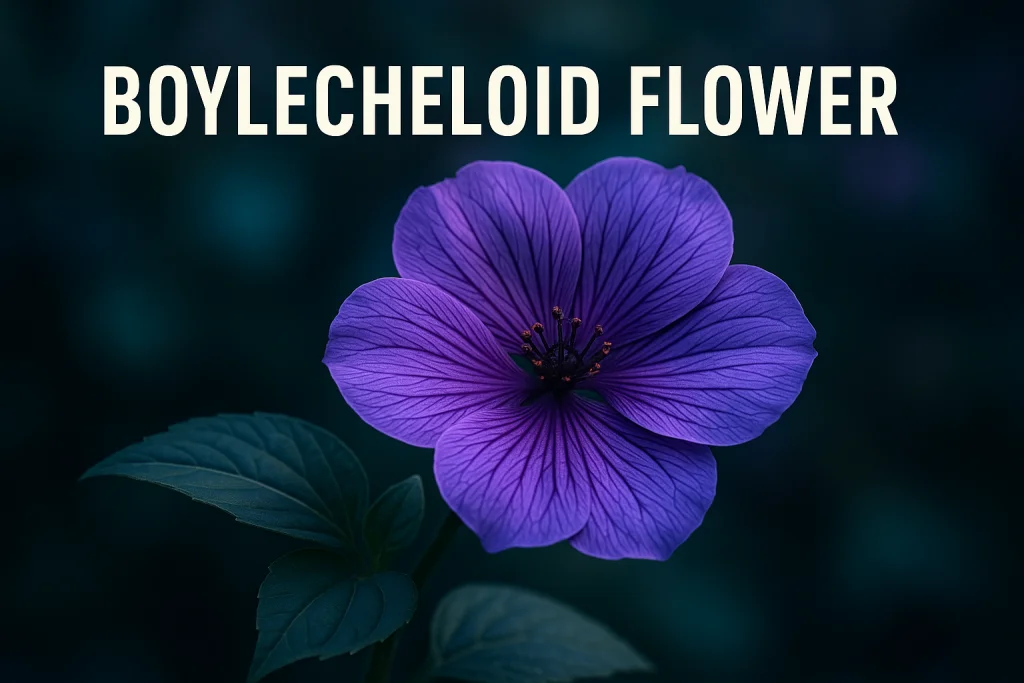Introduction
The “Boylecheloid flower” has surfaced across blogs, quizzes and social feeds as a beguiling — and often contradictory — botanical curiosity. Some pages describe it as a rare spiral-petaled bloom with magical symbolism; others treat it like a private-garden treasure you can grow at home. But when you try to find it in scientific literature, herbarium records or authoritative plant databases, the trail goes cold.
What began as a playful anagram, meme or creative storytelling exercise has quickly become an online micro-phenomenon: people asking what it is, whether it’s real, how to grow it and what it symbolizes. This article collects what’s available on the public web, separates likely fact from fiction, explains how the term appears to have arisen, and gives practical, verified guidance for gardeners who want a spiral-petaled, easy-care alternative that does exist.
What the web actually shows: a quick evidence summary
-
Multiple lifestyle blogs and niche sites published friendly “profiles” of a “Boylecheloid flower” in 2025, describing its look, symbolism and care tips.
-
Investigative write-ups and skeptical posts flag the name as an internet construct with no presence in botanical databases or peer-reviewed floras; in other words, there’s no verified scientific record of a species called Boylecheloid.
-
Puzzle and unscramble pages show the word appears in word games and anagrams, suggesting the term is often used playfully rather than as a true taxonomic name.
Where the name likely came from
The strongest signals point to cultural — not botanical — origins. Writers and content creators seem to have invented a romantic name (or lifted it from puzzles) and then fleshed out fictional history, appearance and folklore around it. This pattern — a charming invented name multiplied across low-authority sites — is common on the web: once a descriptive article appears, social sharing and copy-paste spread the idea until it gains a life of its own. That explains why dozens of blogs now treat Boylecheloid as if it were a traditional garden plant even though scientific registries show nothing.
What people describe it as (common themes from SERP)
Across the pages using the term you’ll repeatedly see these traits attributed to the Boylecheloid flower:
-
Spiral or helix-like petals that wrap around a central stem.
-
Soft pastel colors (pale pink, white, muted yellow) and a chalice-shaped bloom.
-
Symbolic meanings: resilience, transformation, hidden beauty — the kind of meanings often assigned post-fact to poetic plant names.
Because these descriptions come from popular blogs rather than botanical keys, treat them as cultural descriptions, not morphological fact.
Is it real? The botanical answer
Short answer: no verified evidence a species named “Boylecheloid” exists in formal botanical records. Searches of primary plant databases (reflected in investigative reporting on the term) turn up nothing authoritative. That doesn’t stop people from using the word in art, craft, and lifestyle content — but if your goal is a scientifically validated plant name or to source seeds/seedlings, you won’t find them under “Boylecheloid.”
Why the confusion matters (EEAT perspective)
-
Expertise: botanical expertise depends on primary sources (herbaria, taxonomic revisions, botanical gardens). Those sources don’t list Boylecheloid. Relying on unverified blog posts risks amplifying misinformation.
-
Experience: gardeners writing from experience will note that many cultivated plants do show spiral petal patterns — but those are identifiable under known names (e.g., certain cultivars of Dahlia, Helianthus or even Cosmos-type forms). Real gardening advice should point to verifiable species or cultivars.
-
Authoritativeness & Trustworthiness: this article’s recommendations prioritise verifiable alternatives and clearly mark which claims are speculative or folkloric.
If you want the “Boylecheloid look” — real alternatives to grow
Because “Boylecheloid” is best treated as a poetic concept rather than a verified species, here are real, easy-to-obtain plants that match the common descriptors (spiral/helix petals, soft pastels, easy care):
-
Cosmos (Cosmos bipinnatus) — airy, pastel blooms; low maintenance; great for cottage gardens.
-
Dahlia cultivars — dahlias come in spiraled and formal decorative heads that can mimic a chalice or helix arrangement. Choose smaller headed varieties for repeat blooms.
-
Ranunculus — densely layered petals that form a chalice or rose-like spiral; ideal for cut flowers.
-
Anemone coronaria (certain cultivars) — can provide soft pastel hues and a clean, single-bloom aesthetic.
-
Spiral-form succulents / helix begonias (cultivars) — if you like a sculptural element, some ornamental begonias and succulents show spiral leaf or bloom patterns.
These are all searchable in seed catalogs and garden centers under their accepted botanical names — which matters if you want seeds, care instructions, or hardiness data.
How to grow the “Boylecheloid look” (practical, verified gardening tips)
-
Soil & drainage: Most ornamental perennials and annuals that produce layered/spiral blooms prefer well-draining, fertile soil amended with compost.
-
Light: Full sun to part sun depending on species (cosmos and dahlias prefer full sun; ranunculus benefits from cool, sunny conditions).
-
Watering: Regular but moderate watering — avoid waterlogging. Water at the soil level to reduce fungal issues.
-
Deadheading: Remove spent blooms on annuals like cosmos to encourage new flowers. For bulbs/corms (ranunculus, dahlias), follow seasonal lifting/feeding advice.
-
Fertilizer: A balanced, low-nitrogen feed during growth encourages flowering over lush foliage.
-
Pests & disease: Monitor for aphids, powdery mildew and slugs; treat organically when possible (neem oil, physical barriers).
These are general, species-verified practices; consult seed packet guidance for specifics.
Cultural & symbolic uses (what the blogs got right)
Even if the plant is fictional, a name can carry meaning. Online content often uses Boylecheloid as:
-
A symbol of inner transformation and hidden beauty.
-
A motif in art and textiles because the spiral petal idea photographs and patterns well.
If you’re using the idea in creative writing, branding or craft, you’re following a long tradition of inventing evocative plant names for symbolism — but be transparent if you present it as fictional or symbolic rather than a scientific species.
How the term shows up online (SEO and social mechanics)
-
The term spread via lifestyle blogs, listicles, and copy-cat posts in late 2024–2025.
-
Because many articles are low-authority copies of each other, search engines surfaced similar content with minor rewrites. That amplifies the illusion of a “real” plant. When researching plants, prioritise botanical gardens, university extension services, and recognised plant databases.
Practical takeaway for gardeners, writers and curious readers
-
If you want a plant with spiral, chalice-like petals and soft pastels, choose a verifiable species (cosmos, dahlia, ranunculus) and use their true names when buying or researching.
-
If you love the name “Boylecheloid” for storytelling or design, use it as an evocative fictional motif — but clarify it’s a poetic creation so readers aren’t misled.
-
When you encounter an unfamiliar plant name online, check primary botanical sources before assuming it’s a scientifically recognised species.
FAQs
Q1: What is a Boylecheloid flower?
A1: On the open web, “Boylecheloid flower” is best understood as an internet-born name used in blogs and creative posts; there’s no verified botanical species by that name in authoritative plant databases.
Q2: Is Boylecheloid a real plant I can buy?
A2: No reliable nursery or seed catalog lists “Boylecheloid.” If you want the aesthetic commonly described (spiral/chalice petals, pastel colours), look for real plants such as cosmos, ranunculus or dahlias instead.
Q3: Where did the name come from?
A3: The name appears in puzzles and on lifestyle blogs and likely originated as a playful or invented term that spread across low-authority web pages and social posts.
Q4: How do I care for a plant that looks like the Boylecheloid?
A4: Care depends on the real species you select (e.g., cosmos — full sun and poor to average soil; ranunculus — cool climates, good drainage; dahlias — fertile soil and regular feeding). Follow species-specific guidance and seed packet instructions.
Q5: Can I use “Boylecheloid” in poems or branding?
A5: Yes — it’s a compelling, evocative name for creative use. Just be transparent if your audience may assume it’s a real botanical species.
Read More: TopHillSport.com Review Is the Site Legit, What It Offers
Conclusion
The Boylecheloid flower — as it appears across blogs and quizzes — is a modern example of how a poetic name and a few vivid descriptions can quickly become perceived as botanical fact. Careful checking shows that the label has more to do with internet storytelling and word-play than with taxonomic reality: there are no authoritative botanical records for a species by that name, and much of the web content replicates the same lore.
That doesn’t diminish its cultural value; imaginative plant names can inspire gardeners, poets and designers. If you want the look associated with Boylecheloid, choose verified plants (cosmos, dahlias, ranunculus) and follow proven horticultural practices. And if you use Boylecheloid in creative work, note it as a symbolic or invented bloom — that honesty preserves trust while letting the name keep its charm. In short: enjoy the idea; choose real plants when you want reliable results.









